- Where cargo of regular shape and size is loaded, a tight stow from wall to wall should be sought. However, in many instances some void spaces will occur. If the spaces between the packages are too large, then the stow should be secured by using dunnage, folded cardboard, airbags or other suitable means.
| Some information has already been provided about barrels in the "Basic stowage methods" section. This section uses individual examples to point out securing options and covers particular points which have not been dealt with sufficiently clearly previously. | 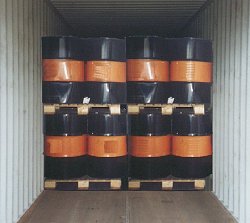 |
| Packing a container with barrels on pallets |
The wording "packing a container with barrels on pallets" has been chosen deliberately, as the barrels have not been palletized, for which they would have had to have been firmly connected to the pallet. Here, the pallets serve on the one hand to rationalize handling and on the other hand as floor and interlayer dunnage. Care is recommended if the dimensions of the barrels do not exactly match those of the container, since stowage gaps are then left which absolutely must be adequately filled.
| Packing progresses | 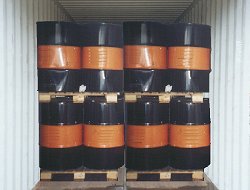 |
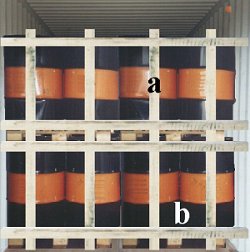 |
Dented barrels should be checked to ensure that the dents do not occupy so much of the volume of the barrels that they may burst as a result of expansion due to heating. | |
| Wooden lattice for securing in the door area |
If the dimensions of the barrels are such that they fill the container to the extent that it can be packed right up to the door, a lattice consisting of vertical boards (a) and horizontal squared lumber (b) is prepared outside the container and positioned in front of the batch. The vertical boards should be positioned precisely centrally against the barrels, so that they assume the task of load transfer precisely at the strongest points of the barrels, namely the upper and lower barrel rims and corrugations.
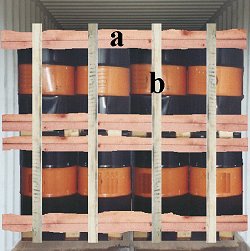 |
It is distinctly less advantageous to construct the lattice from horizontal boards (a) and vertical squared lumber (b), because fewer contact points are available overall. | |
| Less favorably constructed wooden lattice |
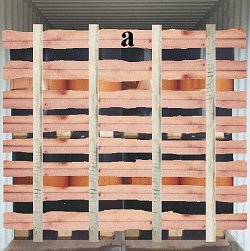 |
To achieve the same number of contact points as with the first lattice, considerably more material would have to be used. | |
| Wooden lattice using too much material |
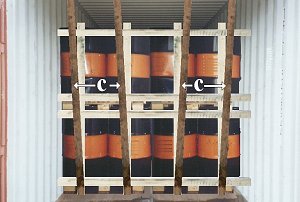 |
Shoring in door area - fitting of oblique bracing (c) |
If a gap is left because of the cargo dimensions, the lattice has to be braced towards the door. This may be achieved on the one hand with horizontally/obliquely fitted squared lumber, which is positioned against the corner posts or, as here, with shoring. To this end, squared lumber members (c) are placed against the feet of the vertical lattice members and positioned obliquely against the top door rail.
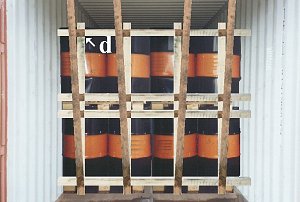 |
Shoring in door area - fitting of horizontal members (d) |
Wooden members are fitted at each layer in the longitudinal direction between the oblique shoring and the horizontal members of the lattice.
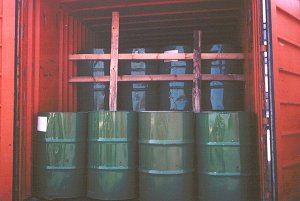 |
Inadequate securing of barrels in door area |
A "lattice" fitted like this cannot prevent the barrels in the top layer from shifting. The vertical boards are only there to hold the horizontal squared lumber in position. The barrels rest with their body, the most sensitive part of a barrel, against the squared lumber.
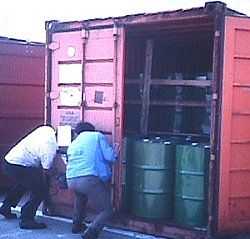 |
|
| Closing a container packed with poorly secured barrels |
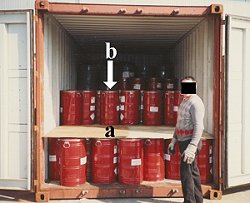 |
Packing a container with pails or small drums |
Interlayer dunnage made of hardboard or thin chipboard is positioned at (a). The main purpose of the boards is pressure distribution. Instead of tiny contact points between individual drums, the weights are distributed over circular strips of the drum rims. Further details about this problem may be found in the section on Static mechanical stresses.
Point 4.3.6 of the CTU packing guidelines is highly relevant to the next packing example:
-
Drums containing dangerous cargoes should always be stowed in an upright position unless otherwise authorized by the competent authority.
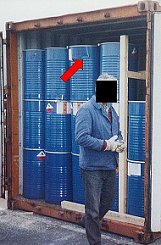 |
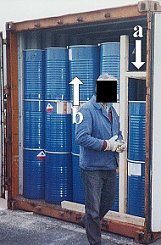 |
||
| Slight shortcomings | Shortcomings eliminated |
Point 4.2.7 of the CTU packing guidelines states, among other things:
-
Packages of dangerous cargoes should be examined and any found to be damaged, leaking or sifting should not be packed into a CTU.
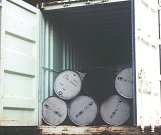 |
 |
||
| Unsecured barrels | Secured with shoring |
Barrels containing hazardous materials must not be packed in the manner shown and even for barrels with normal contents it goes against "standard stowage practice". At any rate, they cannot remain unsecured. Safety can be ensured with shoring.
In the section headed "On completion of packing", point 3.3.1 of the CTU packing guidelines reads as follows:
-
During the final stages of packing a CTU, care should be taken, so far as is practicable, to build a secure face of the cargo so as to prevent "fall out" when the doors are opened. Where there is any doubt as to the security of the cargo, further steps should be taken to ensure security, e.g. by weaving strapping between securing points or placing timber [lumber] between the rear posts.
- that a container on a trailer usually inclines towards the doors; and
- that cargo may move against the doors due to jolts, etc., during transport.
Two factors should be borne in mind:
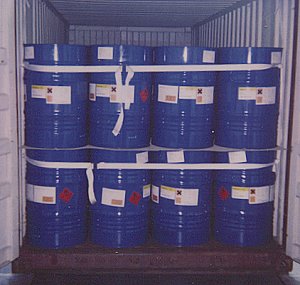 |
|
| Incorrectly arranged securing material |
Since the single-use textile belts have only been fitted in the upper area of the barrels, the barrels, can slip out at the bottom. Given that this form of securing has been selected, the strapping should have been attached at least around the upper and lower thirds of the barrels. The amber traffic light is thus intended to signify "Caution".
The actual implementation and working method in themselves are given a red light. The belts are tightened only across the cargo end face, so generating angles of spread of virtually 180°. This means that the slightest shift in the longitudinal direction may exert extremely large forces on the belt material. This is particularly true of the middle barrels, against which the belts lie completely straight. The angle of spread amounts to 180°, the tangent to 180° is infinite, meaning that the securing force provided by the belts is virtually zero. If such securing means are to be provided, care must be taken to ensure that the fastening belts extend as far as possible into the interior of the container. In this way, the angle of spread (at the outer edges) is avoided and direct securing is produced. However, this does not solve the problem for the middle barrels and should therefore not be used to secure barreled cargoes unless additional aids are provided such as wooden members attached transversely in front of the barrels.
In addition, the straps are knotted, which contravenes the relevant technical rules and German accident prevention regulations.